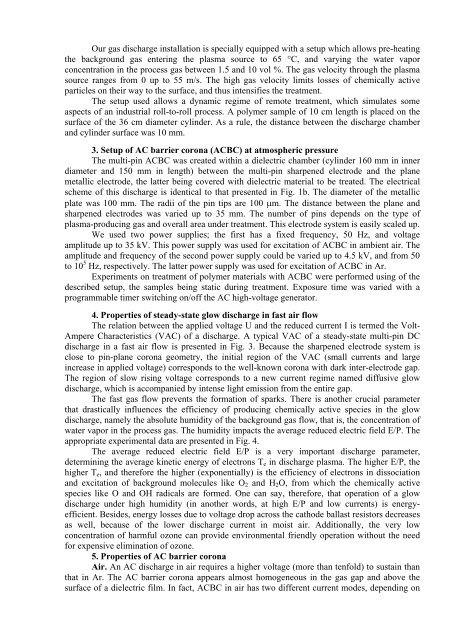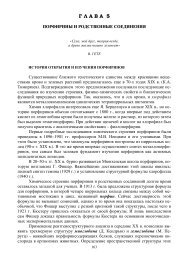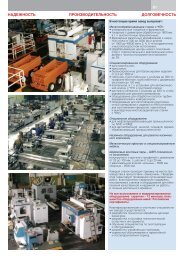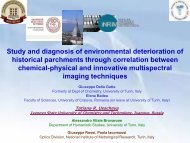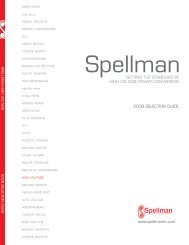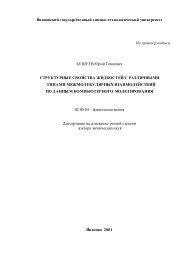DC AND AC NON-THERMAL PLASMA SOURCES FOR COLD ...
DC AND AC NON-THERMAL PLASMA SOURCES FOR COLD ...
DC AND AC NON-THERMAL PLASMA SOURCES FOR COLD ...
Create successful ePaper yourself
Turn your PDF publications into a flip-book with our unique Google optimized e-Paper software.
Our gas discharge installation is specially equipped with a setup which allows pre-heating<br />
the background gas entering the plasma source to 65 °C, and varying the water vapor<br />
concentration in the process gas between 1.5 and 10 vol %. The gas velocity through the plasma<br />
source ranges from 0 up to 55 m/s. The high gas velocity limits losses of chemically active<br />
particles on their way to the surface, and thus intensifies the treatment.<br />
The setup used allows a dynamic regime of remote treatment, which simulates some<br />
aspects of an industrial roll-to-roll process. A polymer sample of 10 cm length is placed on the<br />
surface of the 36 cm diameter cylinder. As a rule, the distance between the discharge chamber<br />
and cylinder surface was 10 mm.<br />
3. Setup of <strong>AC</strong> barrier corona (<strong>AC</strong>BC) at atmospheric pressure<br />
The multi-pin <strong>AC</strong>BC was created within a dielectric chamber (cylinder 160 mm in inner<br />
diameter and 150 mm in length) between the multi-pin sharpened electrode and the plane<br />
metallic electrode, the latter being covered with dielectric material to be treated. The electrical<br />
scheme of this discharge is identical to that presented in Fig. 1b. The diameter of the metallic<br />
plate was 100 mm. The radii of the pin tips are 100 µm. The distance between the plane and<br />
sharpened electrodes was varied up to 35 mm. The number of pins depends on the type of<br />
plasma-producing gas and overall area under treatment. This electrode system is easily scaled up.<br />
We used two power supplies; the first has a fixed frequency, 50 Hz, and voltage<br />
amplitude up to 35 kV. This power supply was used for excitation of <strong>AC</strong>BC in ambient air. The<br />
amplitude and frequency of the second power supply could be varied up to 4.5 kV, and from 50<br />
to 10 5 Hz, respectively. The latter power supply was used for excitation of <strong>AC</strong>BC in Ar.<br />
Experiments on treatment of polymer materials with <strong>AC</strong>BC were performed using of the<br />
described setup, the samples being static during treatment. Exposure time was varied with a<br />
programmable timer switching on/off the <strong>AC</strong> high-voltage generator.<br />
4. Properties of steady-state glow discharge in fast air flow<br />
The relation between the applied voltage U and the reduced current I is termed the Volt-<br />
Ampere Characteristics (V<strong>AC</strong>) of a discharge. A typical V<strong>AC</strong> of a steady-state multi-pin <strong>DC</strong><br />
discharge in a fast air flow is presented in Fig. 3. Because the sharpened electrode system is<br />
close to pin-plane corona geometry, the initial region of the V<strong>AC</strong> (small currents and large<br />
increase in applied voltage) corresponds to the well-known corona with dark inter-electrode gap.<br />
The region of slow rising voltage corresponds to a new current regime named diffusive glow<br />
discharge, which is accompanied by intense light emission from the entire gap.<br />
The fast gas flow prevents the formation of sparks. There is another crucial parameter<br />
that drastically influences the efficiency of producing chemically active species in the glow<br />
discharge, namely the absolute humidity of the background gas flow, that is, the concentration of<br />
water vapor in the process gas. The humidity impacts the average reduced electric field E/P. The<br />
appropriate experimental data are presented in Fig. 4.<br />
The average reduced electric field E/P is a very important discharge parameter,<br />
determining the average kinetic energy of electrons T e in discharge plasma. The higher E/P, the<br />
higher T e , and therefore the higher (exponentially) is the efficiency of electrons in dissociation<br />
and excitation of background molecules like O 2 and H 2 O, from which the chemically active<br />
species like O and OH radicals are formed. One can say, therefore, that operation of a glow<br />
discharge under high humidity (in another words, at high E/P and low currents) is energyefficient.<br />
Besides, energy losses due to voltage drop across the cathode ballast resistors decreases<br />
as well, because of the lower discharge current in moist air. Additionally, the very low<br />
concentration of harmful ozone can provide environmental friendly operation without the need<br />
for expensive elimination of ozone.<br />
5. Properties of <strong>AC</strong> barrier corona<br />
Air. An <strong>AC</strong> discharge in air requires a higher voltage (more than tenfold) to sustain than<br />
that in Ar. The <strong>AC</strong> barrier corona appears almost homogeneous in the gas gap and above the<br />
surface of a dielectric film. In fact, <strong>AC</strong>BC in air has two different current modes, depending on


